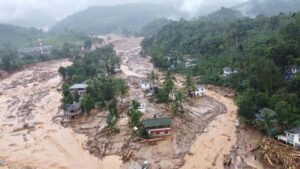Physical Address
23,24,25 & 26, 2nd Floor, Software Technology Park India, Opp: Garware Stadium,MIDC, Chikalthana, Aurangabad, Maharashtra – 431001 India
Physical Address
23,24,25 & 26, 2nd Floor, Software Technology Park India, Opp: Garware Stadium,MIDC, Chikalthana, Aurangabad, Maharashtra – 431001 India

By Vivek Saini
In the wake of the devastating landslides that struck Wayanad in late July, the vulnerability of the Western Ghats has come under renewed scrutiny. Although over a month has passed since the disaster, the implications remain profoundly relevant for regions like Goa, which shares similar topographical and ecological risks. As Goa grapples with the pressures of development and environmental preservation, the lessons from Wayanad serve as an urgent reminder that complacency could have catastrophic consequences. The focus now shifts to how Goa can avoid a similar fate by taking immediate and decisive action.
The Western Ghats and Goa’s Environmental Vulnerability
The Western Ghats, a UNESCO World Heritage site, play a critical role in maintaining the ecological balance in South India. Goa, located along this mountain range, is particularly vulnerable to landslides due to its steep slopes and heavy rainfall. The region’s laterite soil, known for its high water absorption, becomes prone to erosion when disturbed by construction and deforestation.
Environmentalists and experts emphasise that the ongoing deforestation and unregulated development projects in Goa mirror the conditions that led to the Wayanad disaster. Mining activities have severely impacted over 350 square kilometres of forest in Goa, causing soil erosion, water contamination, and biodiversity loss. Without intervention, these factors could trigger catastrophic landslides.
Unchecked Hill-Cutting and Construction: A Recipe for Disaster
Goa’s hilly regions have become a hotspot for unregulated construction driven by private developers and government projects. The destruction of natural slopes, often to make way for luxurious villas and infrastructure developments, has sparked significant concern among environmental activists. Abhijit Prabhudessai, General Secretary of the Federation of Rainbow Warriors, highlights that such activities have already led to several landslides in the state this year, particularly in Khandepar village.
Activists argue that while the state government has established monitoring squads, they remain largely ineffective in curbing illegal activities. Avertino Miranda, convenor of the Goa Green Brigade, points out that the continued hill-cutting increases landslide risks and threatens the state’s aquifers, worsening the ongoing water scarcity crisis.
State Assembly’s Stand on Environmental Concerns
Amidst growing concerns, the Goa Assembly has recognised the need for stricter regulations to protect ecologically sensitive areas. Chief Minister Pramod Sawant has described the Wayanad landslide as an “eye-opener” for Goa, emphasising that there should be “no compromise” on the stability of the state’s ecologically sensitive zones. During assembly discussions, he assured the government would enforce stricter checks on construction activities in landslide-prone areas and stressed the importance of balancing development with environmental sustainability.
The Chief Minister also reiterated the government’s commitment to conducting thorough studies before permitting projects in these areas. This proactive stance comes amidst criticism of past government actions, where rapid and unregulated developments were prioritised over environmental concerns. The assembly’s discussions reflect a growing awareness of the need to preserve Goa’s natural heritage, particularly in light of the alarming parallels between Goa’s environmental issues and those that led to the Wayanad disaster.
Calls for Sustainable Development and Conservation Efforts
In the aftermath of the Wayanad tragedy, environmentalists amplify their calls for sustainable development in Goa. They argue that the lessons from Wayanad should serve as a rallying cry for the state’s residents to protect its remaining forests and regulate construction activities in sensitive areas. Vishwajit Rane, Goa’s Town and Country Planning Minister has rejected recent permissions for hill-cutting, citing over 900 complaints filed by his department. However, activists remain wary, pointing to ongoing projects that disrupt the natural landscape. The audience’s support for these efforts is crucial in shaping Goa’s environmental future.
The need for more robust environmental policies and enforcement in Goa is more urgent than ever. With tourism and mining pressures showing no signs of abating, the state must prioritise ecological preservation to prevent future disasters like Wayanad. Sustainable development not only protects the environment but also contributes to the state’s long-term economic stability.
Goa is at a critical juncture where today’s decisions will determine the state’s environmental future. The tragic events in Wayanad serve as a poignant reminder of the costs of unchecked development. However, by embracing sustainable practices and enforcing strict regulations, Goa has the potential to preserve its unique landscape and avert a potential ecological disaster. This hopeful vision of a sustainable future is within reach, but it requires collective action and commitment from all stakeholders.
References:
Western Ghats | A look into the Gadgil and Kasturirangan Reports in the wake of Kerala Landslides
Photo by Southern Command INDIAN ARMY
Banner Image:
https://twitter.com/IaSouthern/status/1818161493315133730/photo/3